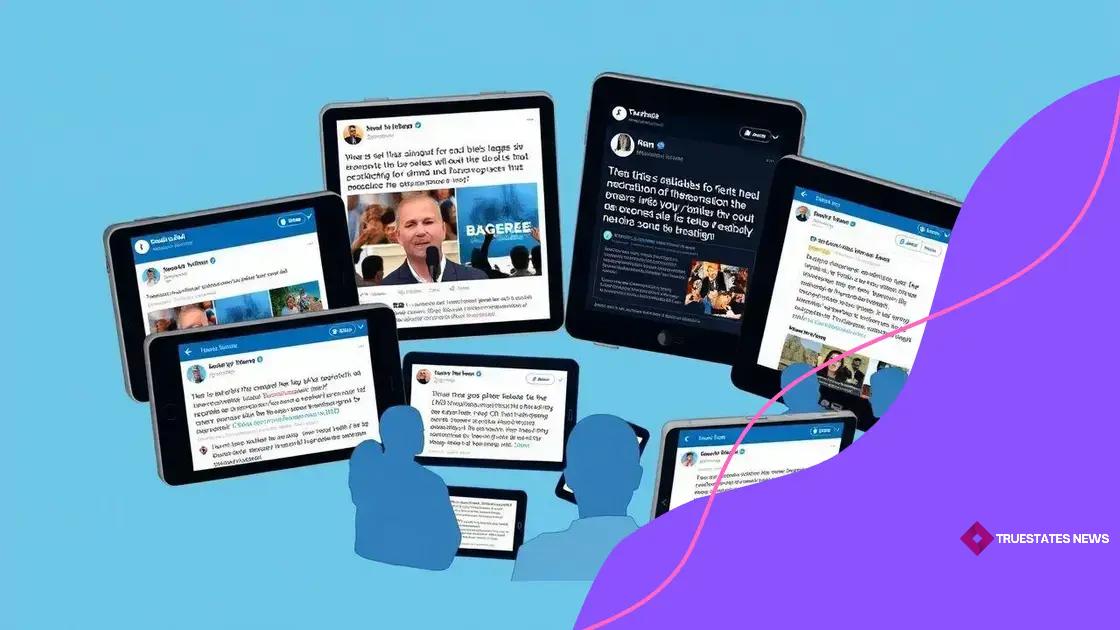Election misinformation: why it matters now more than ever

Election misinformation refers to false or misleading information that can significantly influence voter attitudes and decisions during elections, necessitating public awareness and education to combat its spread.
Election misinformation has become a hot topic in recent years, changing how voters perceive credibility and trust. Have you ever wondered how a single misleading post can influence millions? Let’s dive into this critical issue together.
Understanding election misinformation
Understanding election misinformation is crucial, especially in today’s digital age. With so much information available online, distinguishing between fact and fiction becomes increasingly challenging.
This type of misinformation can spread rapidly, influencing public perception and voter behavior. But what exactly is it?
What is election misinformation?
Election misinformation refers to false or misleading information specifically designed to alter how people perceive elections. It can manifest in various forms, including social media posts, news articles, and even word of mouth.
Types of misinformation
- False information: Deliberate lies spread to deceive voters.
- Misleading content: Information that may be true but presented in a misleading context.
- Outdated information: Data that is still in circulation but has changed since its original posting.
- Fabricated sources: Fake news stories that cite non-existent sources to appear legitimate.
Another important aspect to consider is that election misinformation can be intentional or accidental. Misinformation can stem from misunderstandings or misinterpretations of facts. For instance, a citizen may share a story without verifying its authenticity, thinking they are supporting a good cause.
In addition, different platforms contribute to the spread of election misinformation. Social media networks, forums, and even mainstream news outlets can unintentionally amplify false claims. These platforms provide a larger audience, making it easier for misinformation to gain traction.
The role of fact-checking
Fact-checking is an essential tool in combating election misinformation. By verifying the accuracy of claims, organizations help ensure that voters have access to reliable information. This can empower individuals to make informed decisions at the polls.
Staying informed and vigilant is vital in a landscape filled with misinformation. Voters should learn how to identify credible sources and seek out multiple viewpoints. As the public becomes more informed, the impact of misinformation can be lessened.
Examples of misinformation in recent elections
Examples of misinformation in recent elections show the troubling effects of false information. Understanding how misinformation spreads can help us combat it effectively.
Throughout the last few election cycles, various forms of misinformation have emerged, affecting voter opinions and behaviors. These incidents highlight the need for vigilance.
2020 Presidential Election
During the 2020 U.S. Presidential Election, numerous misleading claims circulated on social media. One notable example was the false assertion that mail-in voting would lead to widespread fraud. Many shared these claims without verifying their accuracy.
Election Day Misleading Posts
On Election Day, posts and memes falsely claimed polling places had closed early or lacked necessary voting materials. Such misinformation created confusion and increased anxiety among voters.
Local Elections
- Altered Images: Some candidates faced manipulated images shared online to misrepresent their statements or actions.
- Fake Endorsements: Misleading claims about endorsements from high-profile figures affected local candidates’ reputations.
- False Reports: Reports of fictitious election changes were circulated, which caused panic among voters.
Fake news sites also contributed to the problem by publishing sensationalized stories that lacked any factual basis. These stories often went viral, reaching thousands before fact-checkers could respond.
Additionally, bots and automated accounts played a significant role in amplifying misinformation, making it more challenging for genuine voices to be heard. By engaging users with misleading content, these accounts skew public perception and hinder informed decision-making.
With increasing awareness of misinformation, it’s crucial for voters to develop critical thinking skills. By questioning the validity of the information they encounter, individuals can better protect themselves and their communities.
The impact of social media on misinformation

The impact of social media on misinformation is significant in today’s digital landscape. Platforms like Facebook, Twitter, and Instagram allow information to spread rapidly, reaching millions of users within seconds.
One of the main ways social media contributes to misinformation is through its algorithms. These algorithms often promote sensational content, regardless of its accuracy. This means that misleading stories can quickly gain traction while verified news may go unnoticed.
Rapid Spread of Rumors
In recent years, we’ve seen how rumors can escalate. Once a piece of misinformation is posted, it can be shared, liked, or commented on, which increases its visibility.
Paid Advertisements
Some individuals and organizations use paid advertisements to push misleading narratives. These ads can appear legitimate, making it difficult for users to discern fact from fiction. This tactic has been used in various campaigns to sway public opinion.
- Targeting Specific Demographics: Advertisements can target individuals based on their online behavior, making misinformation particularly insidious.
- Amplification by Influencers: Influencers can unintentionally spread false information by sharing content that appears credible.
- Echo Chambers: Users often follow like-minded individuals, which can create echo chambers that reinforce false beliefs.
Furthermore, the unregulated nature of social media means that anyone can post information, regardless of its accuracy. Users often don’t verify sources before sharing, which can lead to a snowball effect of misinformation.
Educational initiatives are essential for reducing the impact of social media misinformation. Teaching users how to identify reliable sources and recognize false claims is vital for a well-informed public.
By understanding the role social media plays, users can become more scrutinous about the information they encounter online. This awareness is key to combating misinformation.
How to identify false information
Identifying false information is crucial in today’s digital age. With the rise of misinformation, it has become increasingly important for individuals to develop skills to recognize what is true and what is not.
One effective strategy is to always check the source of the information. Reliable sources typically have a reputation to uphold and provide evidence for their claims. Avoid sharing content from websites without clear authorship or unknown affiliations.
Look for Credible Evidence
When you find a claim that seems suspicious, look for supporting evidence. Credible articles usually cite studies or include expert opinions. If the article lacks credible references, it may be spreading misinformation.
Cross-Check with Trusted Sources
If unsure about the accuracy of a piece of information, cross-check it with trusted news outlets. Many reputable media organizations have fact-checking departments that verify claims and debunk false information.
- Check Dates: Information can become outdated quickly, so ensure the content is current.
- Verify the Author: Research the author to see if they are credible and have a history of reliable reporting.
- Identify Bias: Consider whether the content presents a balanced view or shows clear bias toward one side of an issue.
Understanding the intent behind the information is another key factor. Misinformation is often designed to provoke strong emotions, such as fear or anger. If a headline seems exaggerated or sensational, it’s wise to approach it with skepticism.
Furthermore, social media can play a significant role in spreading false information. Before sharing something from social media, take a moment to investigate its origins. Look at the comments and responses for any indicators that the information is disputed.
Improving media literacy is essential in combating misinformation. Engaging in discussions about how to spot false information strengthens community awareness and encourages everyone to think critically.
Strategies for combating election misinformation
Strategies for combating election misinformation are essential for ensuring the integrity of the democratic process. As misinformation spreads quickly, it is vital to adopt proactive measures to address it.
One effective approach is to educate the public about identifying false information. Teaching individuals how to verify sources and recognize credibility is key. Schools and community organizations can play a significant role in this effort by hosting workshops and seminars.
Utilize Fact-Checking Resources
Encouraging the use of reputable fact-checking websites is another important strategy. Websites like Snopes and FactCheck.org provide valuable resources for verifying claims circulating in the media. Sharing these tools can empower individuals to critically assess the information they consume.
Engage in Community Discussions
Community discussions can create a sense of unity and awareness. Hosting local forums or online discussions permits individuals to share concerns about misinformation. These platforms enable participants to express their views and learn from each other’s experiences.
- Promote Critical Thinking: Teaching critical thinking can enable individuals to ask questions about the information they see.
- Highlight Trusted Sources: Sharing a list of trusted news organizations can help individuals discern credible information from unreliable sources.
- Encourage Open Dialogue: Promoting conversations about misinformation minimizes the stigma around discussing differing views.
Additionally, collaboration with social media platforms is crucial in managing misinformation. Social media companies can implement algorithms to flag false content. By prioritizing transparency, these platforms can help users understand the origins of certain information.
Another strategy is to report misinformation when encountered. Encouraging users to report false claims helps social media platforms take action against misleading content. Users can also support campaigns and initiatives dedicated to fact-checking and combating misinformation.
Lastly, staying informed about emerging trends in misinformation is essential. As tactics evolve, so must our strategies. Regularly updating educational materials and community engagement programs can maintain their relevance against new forms of misinformation.
In conclusion, combating election misinformation is essential for maintaining a healthy democracy. By educating ourselves and others on how to identify false information, we can create a more informed public. Encouraging community discussions and utilizing fact-checking resources are vital strategies. Collaboration with social media platforms and reporting false claims helps reduce the spread of misinformation. Staying vigilant and proactive is the best way to protect our elections and ensure that accurate information prevails.
FAQ – Frequently Asked Questions about Election Misinformation
What is election misinformation?
Election misinformation refers to false or misleading information that can affect voter perceptions and behaviors during elections.
How can I identify false information?
Check the source, look for credible evidence, and use fact-checking websites to verify claims before sharing.
What strategies can help combat election misinformation?
Educating yourself and others, using credible fact-checking resources, and participating in community discussions are effective strategies.
Why is it important to combat misinformation?
Combating misinformation is essential to maintain a healthy democracy and ensure that voters make informed decisions based on accurate information.
